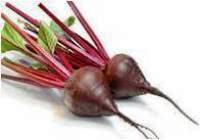I am shocked! Shocked and dismayed…that one of my favourite food writers should write “It is not an inspiring vegetable unless you have a medieval passion for highly coloured food.” Yet this is what Jane Grigson wrote in ‘Jane Grigson’s Vegetable Book” in 1978 of the noble beetroot. True, I might agree with her when she continues, “I have never heard anyone claim it as their favourite” but even so…not inspiring? I grant you that it can get a trifle messy at times, colouring what ought not to be coloured but how can anyone fail to be inspired by its rich opulent red and its fresh, sweet flavour and quite apart from all this it is so beneficial to health. John Gerard, the 17th-century herbalist, deemed it “a most excellent and delicate salad”.
 Beetroot is considered a natural detoxifier, helping the body to eliminate toxins and assisting in preventing the build-up of fatty deposits in the liver. There is evidence that beetroot juice can lead a reduction in blood pressure through its content of dietary nitrate. It contains other goodies like vitamins A, B and C, iodine, calcium, magnesium, potassium and it’s rich in iron. In the early Renaissance, it was recommended to eat beetroot with garlic to avoid garlic on the breath.
Beetroot is considered a natural detoxifier, helping the body to eliminate toxins and assisting in preventing the build-up of fatty deposits in the liver. There is evidence that beetroot juice can lead a reduction in blood pressure through its content of dietary nitrate. It contains other goodies like vitamins A, B and C, iodine, calcium, magnesium, potassium and it’s rich in iron. In the early Renaissance, it was recommended to eat beetroot with garlic to avoid garlic on the breath.
Beetroot can be eaten raw in salads, it can be juiced, steamed, boiled, baked, pickled and if finely sliced and deep-fried it makes an interesting change from potato chippies or why not parboil a few and finish cooking them in with the roast. The young leaves, if you are lucky enough buy beetroot with them on or grow your own are similarly nutritious and can be cooked as you would silver beet.
Where would the New Zealand hamburger be without its slice of beetroot? All right, it comes out of a tin but imagine how much nicer it would be if it was fresh.
A few simple ideas about getting the best from these crimson treasures:
- When preparing raw beetroot, twist the tops off, don’t cut them.
- Choose beetroots of the same size so they cook in the same time.
- Raw beetroot can be kept for about a week before they deteriorate.
- Cooked beetroot can be refrigerated for 3 days or frozen for a month.
Baked Beetroot with Creme Fraiche Dressing
Serves 4
Ingredients:
- 4 medium raw beetroot – washed but unpeeled
- 3 tbsp fresh dill – chopped
- 2 tsp coriander seeds – lightly crushed
- 150ml crème fraiche
- 3 tsp horseradish cream
- Salt and pepper
Method:
Preheat the oven to 200˚C. Wrap the beetroots individually in foil and bake until them feel tender when squeezed, about 1 – 1½ hours depending on their size.
While they are baking mix the other ingredients, reserving a teaspoon of the dill and some of the coriander for garnish.
When the beetroot are cooked, open the foil and split them into quarters. Fill them with the crème fraiche, garnish with the remaining dill and coriander and serve.
Raw Beetroot and Orange Salad
Serves 4 – 6
Ingredients:
- 500g young raw beetroot
- 2 large oranges
- 1 red onion – sliced thinly into rings
- 2 tbsp wine or cider vinegar
- A red lettuce or radicchio
- 5 tbsp Greek-style yoghurt
- 1 tsp wholegrain mustard
- 1 tbsp extra virgin olive oil
- 3 tsp capers – rinsed and dried
- Salt and pepper
Method:
Peel the beetroot (wear gloves if you don’t want to be caught red-handed) then grate them finely into a bowl.
Grate the zest of one orange and reserve for garnish then peel both the oranges taking care to remove all the white pith. Carefully cut between each segment to remove the flesh of both oranges. Mix this with the grated beetroot and half of the sliced onion then stir in the vinegar and season.
For the dressing mix the yoghurt, mustard, oil, orange rind and season. Lay the lettuce leaves on a serving plate and spoon on the beetroot and orange. Dress with the yogurt mix and garnish with the capers and the remaining onion.
By Gerald Bryan









Join the Discussion
Type out your comment here:
You must be logged in to post a comment.